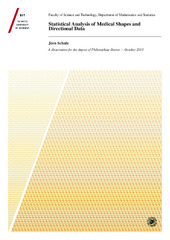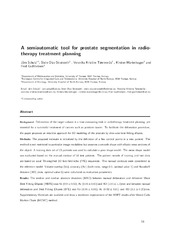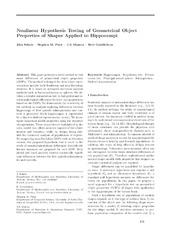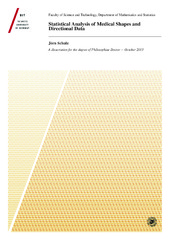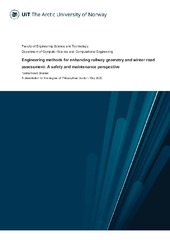| dc.contributor.advisor | Godtliebsen, Fred | |
| dc.contributor.author | Schulz, Jörn | |
| dc.date.accessioned | 2014-02-25T09:14:01Z | |
| dc.date.available | 2014-02-25T09:14:01Z | |
| dc.date.issued | 2013-12-18 | |
| dc.description.abstract | The use of statistical shape analysis in medical settings has increased during the last decades. This thesis presents contributions to three major topics of statistical shape analysis with application to medical problems. These topics are: the modeling of the shape by a geometrical model, the study of rotational shape deformations and the comparison of shapes between populations.
Paper I presents a semiautomatic method for the prostate segmentation in radiotherapy treatment planning. To facilitate the manual delineation of the prostate in medical images, an intuitive approach is developed for 3D modeling of the prostate by slice-wise best fitting ellipses in each image. The focus is to estimate a mean shape from a set of training data and to register the estimate by the definition of a few control points in a new patient. The obtained results are fairly accurate and suggest possible time saving effects.
Paper II studies rotational deformations of objects. The rotational deformations such as twisting or bending have been observed as the major variations in some medical applications, where the features of the deformed 3D objects are directional data. Models and estimators are proposed for one or the composition of two simple deformations based on the directional features. The proposed method uses a generalized small circle fitting on the unit sphere. Two analyses of 3D object data are presented: one using skeletal representations in medical image analysis as well as one from biomechanical gait analysis of the knee joint.
Paper III investigates shape mean differences between two populations using a hypothesis test. Several aspects of a sensitive hypothesis test are elaborated which support accurate statistics of populations. A novel permutation test is developed for data whose representations include both Euclidean and non-Euclidean elements. By supporting non-Euclidean components, the proposed hypothesis test is novel in the study of morphological shape differences. Both global and local analyses showed statistically significant differences between first episode schizophrenics and controls and demonstrated the sensitivity of the method. | en |
| dc.description.doctoraltype | ph.d. | en |
| dc.description.popularabstract | Alle objekter kan beskrives av sin form. Derfor blir statistisk formanalyse brukt i mange anvendelser. Dette er et spennende tverrfaglig felt som involverer flere metoder. Denne avhandlingen presenterer tre ulike tema innen statistisk formanalyse som kan anvendes i medisinske problemstillinger. Disse temaene er:
(1) modellering av former ved bruk av en geometrisk modell,
(2) studiet av roterende formdeformasjoner og
(3) differanser av form mellom populasjoner.
Avhandlingen presenterer en metode for å gi en presis beskrivelse av form og posisjon til prostata. Metoden kan bidra til en tidsbesparelse i forbindelse med strålebehandling av pasienter med prostatakreft. I tillegg har nye metoder for å estimere og modellere rotasjons-deformasjoner av objekter blitt studert. Denne problemstillingen er motivert ut fra at slike deformasjoner ofte bidrar til store utfordringer i medisinske anvendelser. Vellykkede metoder for å analysere biomekanisk gangart av kneleddet har blitt utviklet. Videre er en ny metode for å teste gjennomsnittsdifferanser mellom former studert. Metodenes anvendelighet demonstreres ved testing av formdifferanser mellom hippocampi for schizofrene og en kontroll-gruppe. | en |
| dc.description.sponsorship | This work in this thesis was funded by the Norwegian Research Council through eVita program grant no 176872/V30. The research is performed as part of Tromsø Telemedicine Laboratory, funded by the Norwegian Research Council 2007-2014, grant no 174934. | en |
| dc.identifier.isbn | 978-82-8236-119-4 (pdf) | |
| dc.identifier.uri | https://hdl.handle.net/10037/5869 | |
| dc.identifier.urn | URN:NBN:no-uit_munin_5563 | |
| dc.language.iso | eng | en |
| dc.publisher | UiT Norges arktiske universitet | en |
| dc.publisher | UiT The Arctic University of Norway | en |
| dc.rights.accessRights | openAccess | |
| dc.rights.holder | Copyright 2013 The Author(s) | |
| dc.subject.courseID | DOKTOR-004 | en |
| dc.subject | VDP::Mathematics and natural science: 400::Mathematics: 410::Statistics: 412 | en |
| dc.subject | VDP::Matematikk og Naturvitenskap: 400::Matematikk: 410::Statistikk: 412 | en |
| dc.subject | VDP::Mathematics and natural science: 400::Mathematics: 410::Applied mathematics: 413 | en |
| dc.subject | VDP::Matematikk og Naturvitenskap: 400::Matematikk: 410::Anvendt matematikk: 413 | en |
| dc.subject | VDP::Mathematics and natural science: 400::Information and communication science: 420::Simulation, visualization, signal processing, image processing: 429 | en |
| dc.subject | VDP::Matematikk og Naturvitenskap: 400::Informasjons- og kommunikasjonsvitenskap: 420::Simulering, visualisering, signalbehandling, bildeanalyse: 429 | en |
| dc.subject | VDP::Mathematics and natural science: 400::Information and communication science: 420::Mathematical modeling and numerical methods: 427 | en |
| dc.subject | VDP::Matematikk og Naturvitenskap: 400::Informasjons- og kommunikasjonsvitenskap: 420::Matematisk modellering og numeriske metoder: 427 | en |
| dc.subject | VDP::Medical disciplines: 700::Clinical medical disciplines: 750::Radiology and diagnostic imaging: 763 | en |
| dc.subject | VDP::Medisinske Fag: 700::Klinisk medisinske fag: 750::Radiologi og bildediagnostikk: 763 | en |
| dc.title | Statistical Analysis of Medical Shapes and Directional Data | en |
| dc.type | Doctoral thesis | en |
| dc.type | Doktorgradsavhandling | en |


 English
English norsk
norsk